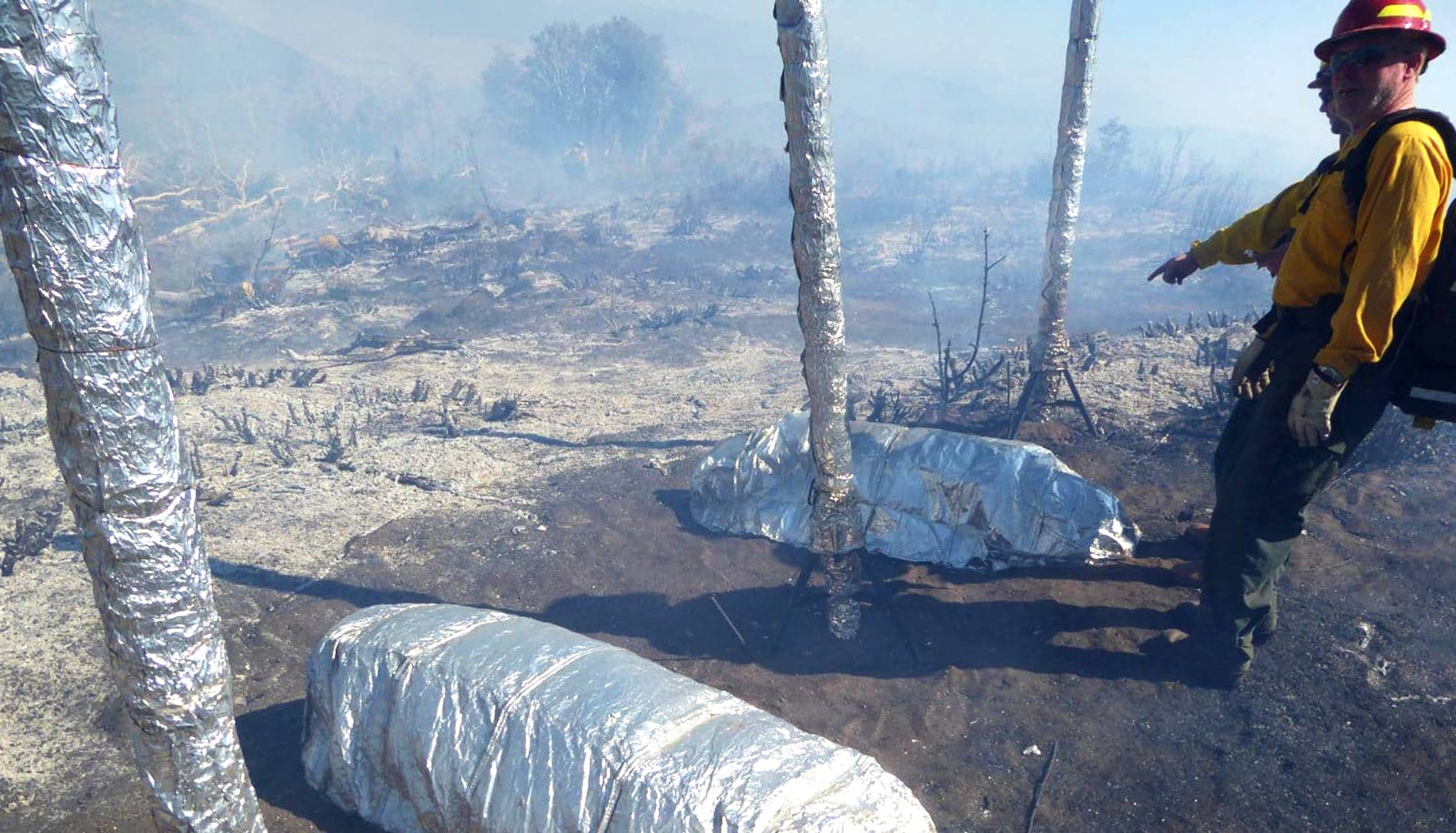
"While there's no such thing as 'fire-proof,' what we're trying to do is to buy more time," says Roger Barker. "We were able to demonstrate our shelters could increase the time to failure—time that could be critical for survival." (Credit: Joseph Roise)
New shelter designs boost firefighters’ survival chances
"For the wildland firefighter, deploying a shelter is the last thing they want to do—it's the final resort, the last line of defense," says Roger Barker.
Four new designs for shelters to protect firefighters trapped in wildfires could increase survival time compared with the current industry standard, according to a new study.
In lab simulations of wildfire burn-overs—where a wildfire sweeps over a group of trapped firefighters or equipment—temperatures inside the shelters remained within survival limits for longer, and the shelters took longer to break open.
Researchers hope the findings in the International Journal of Wildland Fire , as well as from field tests conducted across North America, could spur the development of new, better shelters. In addition, they hope the findings will inform new standards for shelter design and testing.
“For the wildland firefighter , deploying a shelter is the last thing they want to do—it’s the final resort, the last line of defense,” says coauthor Roger Barker, professor of textile technology at North Carolina State University and the director of the Textile Protection and Comfort Center (TPACC).
“While there’s no such thing as ‘fire-proof,’ what we’re trying to do is to buy more time. We were able to demonstrate our shelters could increase the time to failure—time that could be critical for survival.”
One problem with the industry standard shelter is that the aluminum outer layer will melt in contact with direct flame.
“In light of the failure mechanisms of shelters that we observed during wildland fires, we thought we could develop better shelters that provide enhanced protection by incorporating an inner heat-blocking barrier and additional thermal insulation into the construction,” says lead author Joseph Roise, professor of forestry and environmental resources. “We know we can make a better shelter.”
With that goal in mind, the researchers designed two leading prototypes and two lighter versions weighing less than 5 pounds. They added insulating materials, and experimented with different seam designs to keep them from falling apart.
In the TPACC lab, researchers tested the designs against the industry standard in a test chamber called the PyroDome Turbulent Flame Fire Shelter Test System. They blasted the shelters with direct flame from propane burners for 60 seconds, and measured how long it took the temperature at the floor of the shelters to reach 302 degrees Fahrenheit, the temperature threshold for survival. They also set up cameras inside PyroDome to see when the inner layer of the shelters would break open.
All of the prototypes improved survival metrics compared to the standard, which reached the survival limit in less than 40 seconds. Meanwhile, the temperature in one of their designs was nowhere near the survival limit temperature at 60 seconds.
The researchers also tested the shelters’ performance in variety of conditions in controlled burns in Canada, California, North Carolina, and South Dakota. However, they found the field tests were not reliable enough to draw statistically significant conclusions because of wind, fuel, and fire conditions.
“We went all over North America to find different fire conditions that would give different types of fire exposures,” Barker says. “What we found is there is so much variability in the field test, confirming how useful it was for us to have PyroDome.”
The two tests in southern California had the best burn conditions, and researchers saw one of their prototypes performed well in a burn-over. In a test in South Dakota, researchers witnessed shelter failures when grass roots caught fire to spread under the walls inside the shelter. That underscored the importance of fully clearing the area around the shelter, and even scraping down underneath them to remove all organic material.
“If you have a sample of two, you can’t make any statistical comparisons,” Roise says. “But we did see that after the test in California, one of our best-performing prototypes got the full brunt of the fire. It was totally burned on the outside, but the inside was undamaged.”
The findings could give manufacturers and people developing these shelters a new target to shoot for in terms of both how to test them and minimal performance requirements, Barker says.
John Williams, a former research assistant in forestry and environmental resources at NC State, and John Morton-Aslanis, a research assistant in TPACC, are study coauthors. The Department of Homeland Security FEMA Assistance to Firefighters Grant Program funded the work.
Source: NC State
The post New shelter designs boost firefighters’ survival chances appeared first on Futurity .
Share this article:
This article uses material from the Futurity article, and is licenced under a CC BY-SA 4.0 International License. Images, videos and audio are available under their respective licenses.
Related Articles:
Why a warmer world may mean a wetter Arctic
Nov. 2, 2018 • futurityHere’s why it’s so incredibly cold in Europe
Jan. 30, 2019 • futurityLinks/images:
- https://doi.org/10.1071/WF21102
- https://www.futurity.org/wildfires-gel-fire-retardant-2173622/
- https://www.futurity.org/prescribed-burns-wildfires-2294572-2/
- https://www.futurity.org/wildfire-climate-change-forests-2604982-2/
- https://news.ncsu.edu/2022/06/new-fire-shelter-prototypes-could-buy-time-for-wildfire-firefighters/
- https://www.futurity.org/firefighters-fire-shelters-2757062-2/
- https://www.futurity.org


